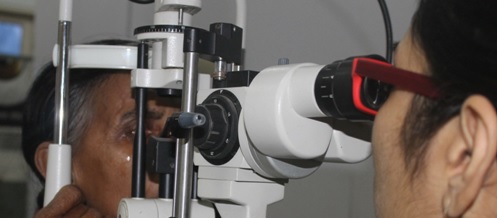Cornea Clinic
The cornea is the eye's outermost layer. It is the clear, dome-shaped surface that covers the front of the eye. The cornea is the transparent front part of the eye that covers the iris, pupil, and anterior chamber. Although the cornea is clear and seems to lack substance, it is actually a highly organized group of cells and proteins. Unlike most tissues in the body, the cornea contains no blood vessels to nourish or protect it against infection. Instead, the cornea receives its nourishment from the tears and aqueous humor (a fluid in the anterior portion of the eye) that fills the chamber behind it. The cornea must remain transparent to refract light properly, and the presence of even the tiniest blood vessels can interfere with this process. To see well, all layers of the cornea must be free of any cloudy or opaque areas.
Cornea is normally clear and has a shiny surface because there are no blood vessels in the cornea. The cornea is extremely sensitive – there are more nerve endings in the cornea than anywhere else in the body. The adult cornea is only about 1/2 millimeter thick and is comprised of 5 layers: epithelium, Bowman's membrane, stroma, Descemet's membrane and the endothelium.
KBHB Eye Hospital’s Cornea clinic is fully fledged department which offers comprehensive medical and surgical care to all diseases of the cornea came into being in 2003. We are a tertiary referral centre for the management of infectious and non infectious keratitis. Initial management of most corneal infections include a scrape and culture plus sensitivity of the infectious material in liaison with a reputed microbiological lab, the result of which decides further management. Prompt broad spectrum therapy is instituted and a close follow up initiated.
KBHB Eye Hospital is providing consultation and treatment on all kinds of corneal diseases like:
 Allergies
Allergies
 Conjunctivitis (Pink Eye)
Conjunctivitis (Pink Eye)
 Corneal Infections
Corneal Infections
 Dry Eye
Dry Eye
 Fuchs' Dystrophy
Fuchs' Dystrophy
 Herpes Zoster (Shingles)
Herpes Zoster (Shingles)
 Iridocorneal Endothelial Syndrome
Iridocorneal Endothelial Syndrome
 Keratoconus
Keratoconus
 Lattice Dystrophy
Lattice Dystrophy
 Map-Dot-Fingerprint Dystrophy
Map-Dot-Fingerprint Dystrophy
 Ocular Herpes
Ocular Herpes
 Pterygium
Pterygium
 Refractive Errors
Refractive Errors
 Stevens-Johnson Syndrome
Stevens-Johnson Syndrome
Corneal Transplant
A corneal transplant involves replacing a diseased or scarred cornea with a new one. When the cornea becomes cloudy, light cannot penetrate the eye to reach the light-sensitive retina. Poor vision or blindness may result. In corneal transplant surgery, the surgeon removes the central portion of the cloudy cornea and replaces it with a clear cornea, usually donated through an eye bank. The surgeon places the new cornea in the opening and sews it with a very fine thread. The thread stays in for months or even years until the eye heal properly. Following surgery, eye drops to help promote healing will be needed for several months.
KBHB Eye Hospital is also leading hospital performing corneal transplant surgeries in Mumbai and Maharashtra. KBHB Eye Hospital is attached with various Eye Banks in Mumbai. Our clinic are also getting more no of referrals from various ophthalmologists and hospital for corneal transplant surgeries.
Keratoprosthesis
Performed as a last resort in eyes with severe anterior segment distortion and multiple corneal graft failures.Usually done in bilaterally corneal blind with good optic nerve function.
Pterygium management
We perform suture less glue less Pterygium surgery wherein the harvested conjunctival graft is kept in place by the adhesive properties of the patients own serum oozing at the surgical site.
Keratoconus
Keratoconus management strategies routinely employed include topographic evaluation, Collagen cross linking and Soft, RGP or scleral contact lens fitting for mild to moderate cases and Deep anterior lamellar Keratoplasty for advanced cases. Hypotonic CXL is done in patients with thinner corneas.
Ocular surface disorders and ocular allergy:
 Ocular trauma clinic
Ocular trauma clinic
 Medical management of ocular allergy.
Medical management of ocular allergy.
 Comprehensive multidisciplinary approach to ocular surface disorders (the majority of which is dry eye and meibomian gland disease) diagnosis and management.
Comprehensive multidisciplinary approach to ocular surface disorders (the majority of which is dry eye and meibomian gland disease) diagnosis and management.
 Ocular surface Neoplasia are dealt with excision, cryotherapy ,lamellar grafting or Amniotic membrane grafting plus topical anti mitotic therapy
Ocular surface Neoplasia are dealt with excision, cryotherapy ,lamellar grafting or Amniotic membrane grafting plus topical anti mitotic therapy
 Medical and surgical management of severe ocular chemical injuries and disorders like Steven johnson’s syndrome and Ocular cicatricialPemphigoid.
Medical and surgical management of severe ocular chemical injuries and disorders like Steven johnson’s syndrome and Ocular cicatricialPemphigoid.
 Proper counselling is given to these patients regarding lid and lash hygiene, use of lubricants, post op care and duration of treatment.
Proper counselling is given to these patients regarding lid and lash hygiene, use of lubricants, post op care and duration of treatment.
 Surgical management of corneoscleral lacerations with management of concurrent cataracts and post surgical visual rehabilitation
Surgical management of corneoscleral lacerations with management of concurrent cataracts and post surgical visual rehabilitation
